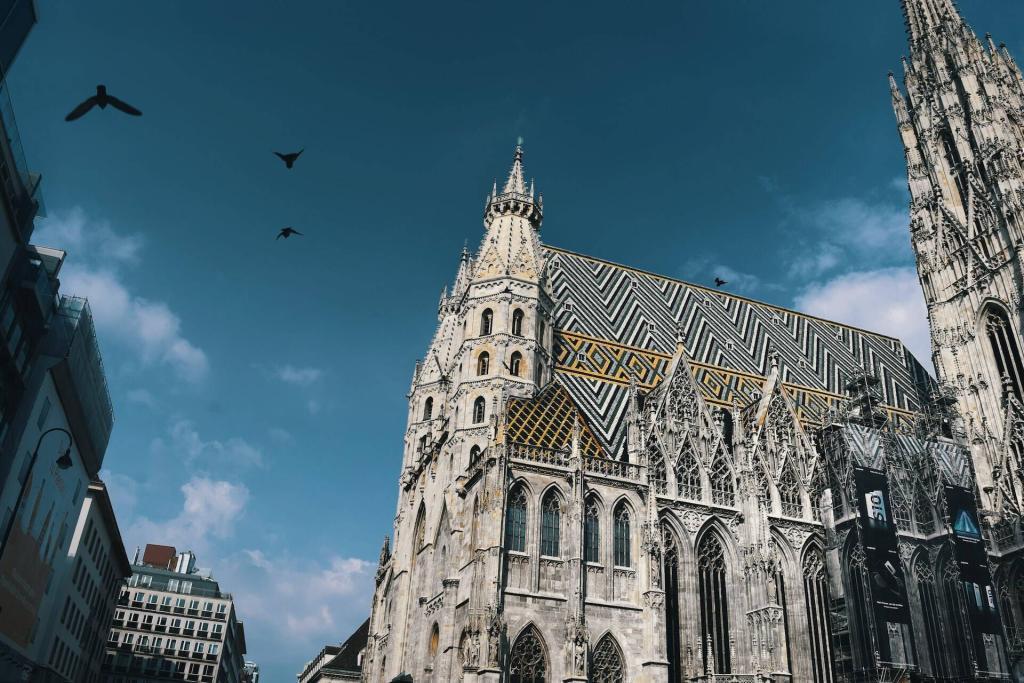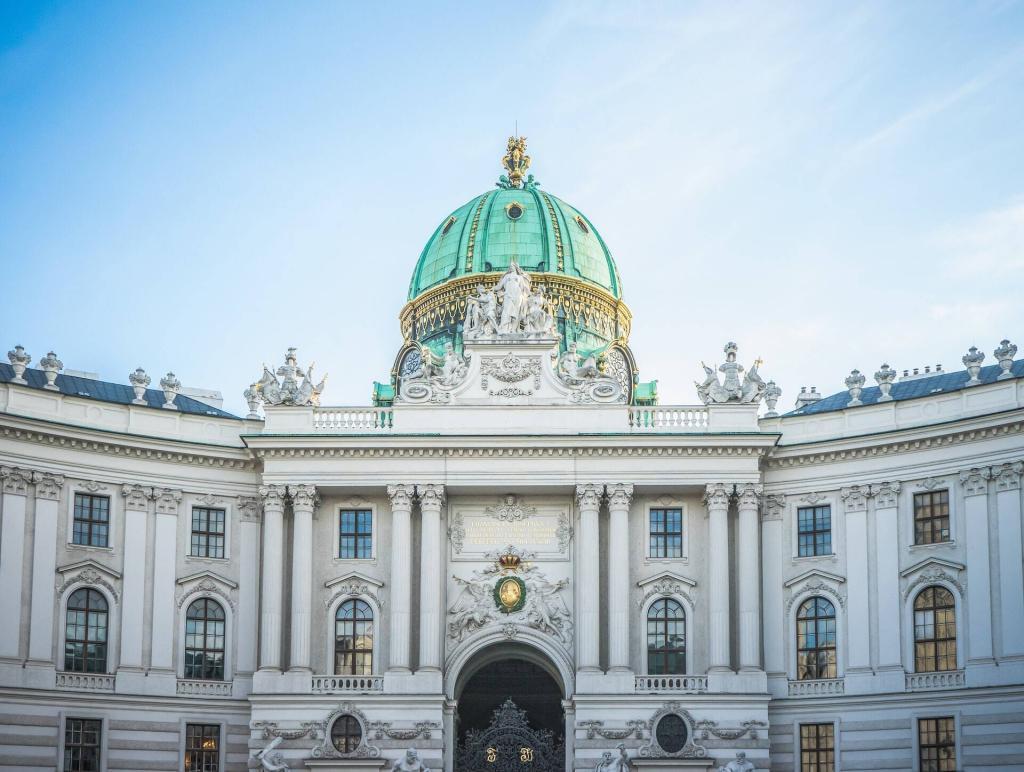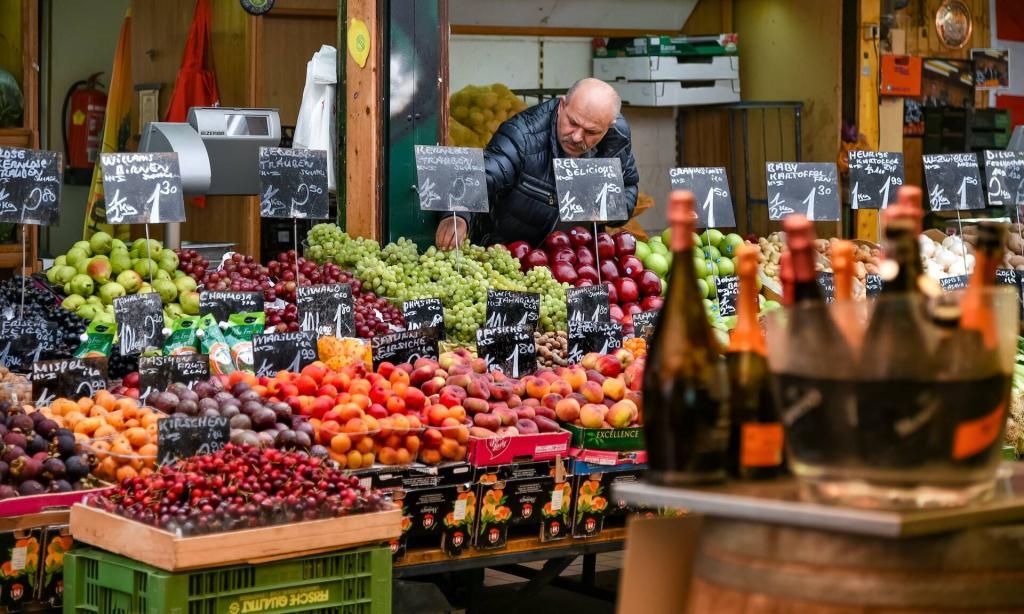The Austro-Hungarian Empire was, between 1867 and the beginning of World War I, one of the great powers of the planet. Vienna, one of its capitals along with Budapest, retains much of the power and elegance of that empire.
Ruled for centuries by the House of Habsburg, this Austrian city saw the parade of fundamental historical figures, from the rebellious Empress Sisi to the brilliant musician Wolfgang Amadeus Mozart, who composed his most renowned pieces in apartment number 5 on Domgasse Street.
Among the attractions of this beautiful city, home to almost 2 million people, are: St. Stephen’s Cathedral, the Hofburg and Schönbrunn palaces, the Opera House and the majestic Parliament, which stands out without complexes on the circular Ringstrasse avenue.
St. Stephen’s Cathedral

In the center of Vienna, more precisely in Stephansplatz, is located the majestic St. Stephen’s Cathedral, one of the most spectacular places to see in Vienna.
Built on a Romanesque church of the early twelfth century, this temple is the highest religious reference of the city. Already from the outside it impresses with its towering tower of 137 meters, which can be accessed to get the best views of Vienna.
Inside, it combines Baroque and Gothic styles in an exquisite way. Worth a visit are the Catacombs, the Pilgram Pulpit – a work of art so realistically carved that it is surprising – and the gigantic Pummerin Bell, which weighs 20 tons and has a diameter of three meters.
The mystique of Mozart is always present, since the brilliant musician was married under this roof and his funeral was held here.
Hofburg Palace

The Hofburg Palace is a fabulous architectural complex, which served as the residence of the powerful Habsburg family until World War I and is another of the must-see sites in Vienna.
Each room of this palace is a museum in itself, from the imperial apartments to the Imperial Chapel, the Treasury Chamber and the luxurious Court Silverware.
Special mention should be made of the Sisi Museum, whose objects, dresses and portraits tell the story of the life of Elisabeth of Bavaria, Empress of Austria from 1854 to 1898.
Naschmarkt Market

The Nashmakt market is a real delight for the senses. It is the oldest in the city and has been open every day at 6 a.m. for five centuries.
It has more than 100 fresh food stalls and in several of them you can take a seat to taste a Viennese sausage or indulge in an apfelstrudel, the most coveted apple pie in Europe. An early morning visit is recommended. It is closed on Sundays.
Vienna Opera House

Another of the historic buildings to see in Vienna is the Vienna State Opera, which was inaugurated in 1869 with a concert by Mozart himself.
Although the Renaissance building is sumptuous, its architect committed suicide at the end of construction because he felt that the building was not up to the mission he had been entrusted.
Despite this misfortune (and the fact that the second architect died of a heart attack during construction), for decades this building has served as the headquarters of the most prestigious opera house in the world.
Visitors to Vienna can not miss this place and, in the best case, attend an opera performance, with tickets costing from 3 euros (to see an opera standing) to 150 euros for the best seats.
Schönbrunn Palace
The Shönbrunn Palace was built during the 17th century and is a huge palace of more than 40 rooms, with beautiful gardens to walk around for hours that undoubtedly make it another of the spectacular places to see in Vienna.
This building was the summer residence of the imperial family and retains its luxurious rooms, decorated in a rococo style, such as the Breakfast Room, the Circular Chinese Room, the Blue Chinese Room and the Great Gallery.
Next to the palace is the fantastic Imperial Carriage Museum, with 170 vehicles ranging from sleighs to carriages in which figures such as Napoleon and Empress Sisi rode. The pieces on display are truly impressive.
The visit can conclude with a tour of the Tiergarten, also called Schoenbrunn Zoo, the oldest zoo in the world, declared Imperial menagerie in 1752.
Spanish Riding School
The Spanish Riding School is part of the Hofburg Palace and has been dedicated to the dressage of horses since 1572. Its large baroque hall, designed to teach the old Viennese aristocracy how to ride, is impressive.
One of the best things to do in Vienna is to attend a training session for the majestic Lippizan horses, the oldest equine breed in Europe.
These sessions are held Tuesday through Saturday, 10 a.m. to noon, with gala performances every Sunday morning. Guided tours are also available, at a cost of 18 euros per person.
Austrian Parliament
On the five-kilometer-long Ringstrasse avenue, which extends like a circular ring around the center, are located the most important historical buildings to see in Vienna, including the imposing Austrian Parliament.
This precinct was built in the 19th century in a neoclassical style and has two session rooms where the Federal Council and the National Council operate. A guided tour of its interior is highly recommended.
Crypt of the Capuchins
Another of the historical sites to see in Vienna is the Capuchin Crypt, where the remains of 12 emperors, 18 empresses and 149 members of the powerful Habsburg royal family rest.
This imperial crypt is located under the Capuchin Church, built between 1622 and 1632, and it is worth paying attention to the sarcophagus of Emperor Franz, the sarcophagus of Maria Theresa and her husband, and the sarcophagus of Elisabeth of Bavaria.
Hundertwasserhaus

Very close to the Prater, the oldest amusement park in the world (with its characteristic 60-meter Ferris wheel), more precisely between numbers 34 and 38 Kegelgasse, is the Hundertwasserhaus, by the artist Friedensreich Hundertwasser, who is known to many as the Austrian Gaudi and is one of the most photographed places to see in Vienna by tourists.
The house he built looks like a real puzzle of colors, with irregular shapes and trees that literally come out of the rooms. Attached to the house is a nice shopping center with the same aesthetics, called Hundertwasserhaus Village.
Mozart House
Another of the historical sites to see in Vienna is in the anonymous apartment number 5 on Domgasse Street, which was once the home of Wolfgang Amadeus Mozart, considered the most brilliant composer in history.
He lived here for three years (between 1784 and 1787) and composed his most accomplished works during his period of greatest creative expression. In the tour of the museum you can discover musical instruments and various objects that belonged to the musician.
Belvedere Palace
Another must-see in Vienna is the Belvedere Palace, which was the summer residence of Prince Eugene of Savoy. It is a baroque palace with sumptuous gardens and fountains. This former imperial building is divided into two parts: the Upper Belvedere and Lower Belvedere.
Inside you can visit different rooms, such as the Marble Gallery, the Hall of the Grotesques and the Hall of Mirrors, but the great attraction is a work by Gustav Klimt, The Kiss, which is exhibited in one of the rooms of the Upper Belvedere.
Stadtpark
The Stadtpark is a green space located in the center of Vienna, very close to the Opera House. It covers an area of 65,000 square meters and is a favorite place for the Viennese to take a breath of fresh air on sunny days.
It has an English style and is bordered by the Wien River. The most famous postcard of the park is the bronze statue of the famous Austrian composer Johann Strauss.
Church of St. Charles Borromeo
A striking religious building with an imposing dome: St. Charles Church, the last great work of the famous Baroque architect Johann Bernhard Fischer von Erlach.
